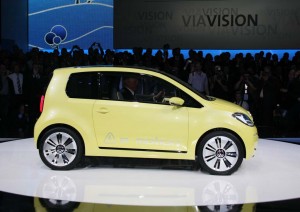Volkswagen plans to begin market an electric vehicle in China as early as 2013, and may design a battery vehicle specifically for the Asian nation, a senior company official said.
Now the world’s largest national automotive market, China is struggling with a variety of problems, including the challenge of maintaining oil supplies and the need to reduce the severe pollution that chokes its major cities. That has led the Beijing government to encourage makers, both domestic and foreign, to begin turning to electric propulsion.
Karl-Thomas Neumann, the president of Volkswagen China Group, said VW will produce battery-electric cars, or BEVs, in China, through its two separate joint ventures, one with FAW Group, the other with SAIC Motor. During a conference on electric vehicles in Shenzhen, Neumann also suggested VW may develop a battery car specifically for the Chinese market.
Currently, Volkswagen is working on a variety of electrification programs, from conventional hybrids to pure BEVs. Among the latter is the eUP, a battery-powered version of its new microcar, the VW UP. Its first model to reach China will be a hybrid version of the Touareg SUV, which will go on sale there this year.
“There is a very strong argument that electric cars are the right move for China, although there are still many challenges,” Neumann said, during the Shenzhen event. “China is making huge investments in renewable energy.”
The challenge is getting Chinese consumers to go along. Demand has remained low in a country that is increasingly focused on price as China’s emerging middle-class takes to the highway.
The new Drive Green study, from the consultancy J.D. Power and Associates, forecasts demand for hybrids and plug-ins will grow modestly, over the coming decade, in China, reaching just 100,000 a year by 2020. The same study predicts the Chinese market for pure battery vehicles will surge to 332,000 annually, over the same timeframe. (Click Here for more on the Drive Green study.)
The command economy, however, allows for a push from Beijing, and the government has been manipulating taxes – and incentives – to encourage consumers to go green(er). Among other moves, consumers can now take advantage of a 60,000 yuan (approximately $9,000 subsidy) on more advanced plug-ins and BEVs.
Other makers are betting on China’s government to spur demand. That includes local maker BYD, which last year introduced the world’s plug-in hybrid vehicle in its home market. BYD happens to be the largest supplier of lithium-ion batteries for telecommunications applications and hopes to use its know-how to get a lead in plug-ins and BEVs.
But foreign makers see the need to electrify if they’re to remain a dominant force in China’s booming market.
That includes General Motors, which also has a joint venture with SAIC. It will begin selling both the Chevrolet Volt and similar Opel Ampera plug-in models in China next year. Meanwhile, a new Memorandum of Understanding between GM and SAIC will likely provide the Chinese maker know-how to begin producing battery cars of its own. (Click Here for more on that deal.)
Other foreign makers who have already announced battery car plans for China include Daimler – parent of Smart and Mercedes-Benz – as well as Nissan, whose new BEV, the Leaf, is just going on sale in the U.S.

